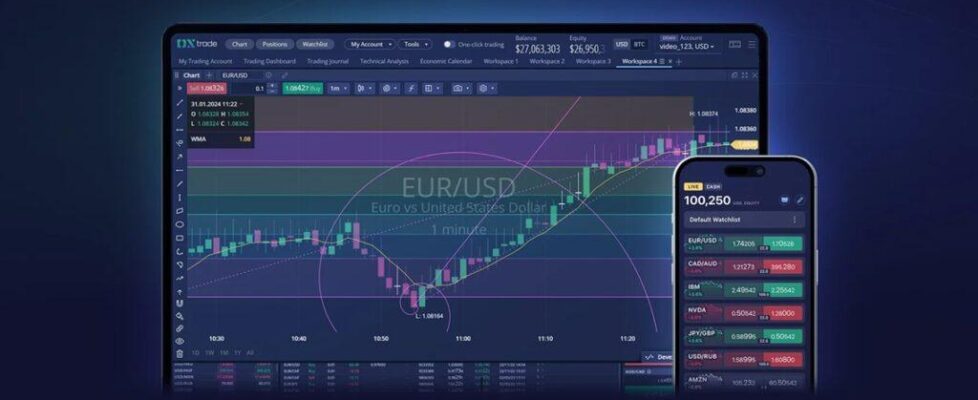CFDs and Multi-Asset Platforms: The Future of Trading?
All eyes have been on multi-asset trading platforms combining equities, exchange-listed derivatives, and contracts for difference (CFDs).
Brokers see the writing on the wall—modern traders want and need diversity of choice, and there’s serious money to be made by meeting those demands.
In this article, we are joined by Jon Light, Director, Head of OTC Platform at Devexperts, to add insight on the following discussion areas:
- Why brokers are prioritizing CFDs and multi-asset platforms as key offerings
- How to get it done—technology considerations?
A closer look at CFDs
CFDs have been a hot topic for good reason—leverage. They let traders access a wide range of markets without needing to own the assets, which means lower costs and more trading opportunities. This appeals to both beginners looking to start small and experienced traders who value leverage and variety.
For brokers, CFDs can be a goldmine, and for the cherry on top, they don’t require as much operational overhead as traditional exchange-traded products.
If we take XTB for example, their 2024 Q3 reporting shows CFDs as their main revenue generator, reaching PLN 470.2 million—a 67.4% year-over-year increase.
Brokers aren’t blind to this. Offering CFDs is becoming a lighthouse beacon for accessing a larger piece of the profit pie.
Regulatory considerations
While CFDs face regulatory scrutiny in several jurisdictions, many brokers operate under multiple frameworks to balance compliance with competitive offerings. Brokers can lean on vendors to make sure their platform is always aligned with current legislation.
The rise of multi-asset platforms
Multi-asset trading platforms make it super easy for traders to access a wide range of financial instruments, including stocks, funds, forex, cryptocurrencies, commodities, indices, and bonds, all within a single interface.
This all-in-one convenience has become a baseline expectation for modern traders.
“Demand for multi-asset platforms will only grow as traders seek flexibility and control,” predicts TradingView.
 Jon also provided thoughts on this dynamic from a vendor perspective.
Jon also provided thoughts on this dynamic from a vendor perspective.
“Traders don’t want to (and won’t) jump between platforms anymore; they want simplicity and control. To give you an example of how this is dominating broker priorities—we have integrated TradingView directly into our platforms to provide traders with their ideal environment.
“With the continuing rise of CFDs and crypto, more and more traders are diversifying their portfolios. This is evolving in line with our broader expectations from technology beyond trading. The user experience must be super streamlined and almost effortless—the less apps and clicks needed to manage a portfolio the better. This of course also plays into retention and engagement of end-users.”
Essentially, brokers can hedge client positions in other markets. For traders, it means diversifying their portfolios, and spreading their investments to mitigate risks—using a single account with access to global markets.
Custom platforms over off-the-shelf solutions
To tap into these trends, brokers need to offer a unified trading hub.
The challenge is ensuring the combined tools and services work together in a way that’s intuitive and reliable.
When it comes to building a multi-asset platform or expanding CFD offerings, brokers have two choices: an off-the-shelf solution, or to go custom—which is what Devexperts offers and recommends.
Both have their place, but custom platforms often come out on top, especially for brokers aiming to stand out.
“We’re seeing many new and existing clients gravitate towards CFDs as a main offering. DXtrade CFD being a multi-asset platform means we attract brokers who have seen the trend and are ready to move and adapt to the demands of the market. That is one option; we also have brokers coming to us wanting to build beyond that, to create a professional and modern one-stop-shop, with all the unique bells and whistles they need.”
Custom platforms give brokers the chance to tailor every detail. Brokers can integrate UI/UX design catering to their specific client base.
Custom platforms are also inherently more scalable and adaptable to market changes. Brokers can add new features, asset classes, or regulatory compliance updates without being restricted by the limitations of a pre-built system.
On the flip side, off-the-shelf platforms are quicker to deploy and cheaper upfront, making them a solid choice for brokers testing the waters or just starting out.
These solutions come with pre-built integrations and a standard set of tools, which can be a great starting point. The trade-off? Fewer chances to create a unique experience.
“A custom platform is like having a suit tailored to you versus buying one off the rack. Often a major compromise is launch times, but in our case, we have over 900 developers, so we can still deliver relatively fast deployment.
“In the end, it comes down to what the broker’s goals are—brokers using off-the-shelf solutions may struggle to differentiate themselves in a crowded market where traders have endless options,” said Jon.
Long story short
With the emerging reporting on revenue generated by CFDs alongside traders’ preference for centralized services in one place, brokers will no doubt be contemplating the move (if they haven’t already done so!).
As explored, they will need to weigh up their requirements and goals, to decide on the best way forward to adapt their infrastructure.
Connect with Devexperts
To follow more of Devexperts’ commentary on current trends, connect with us on LinkedIn. If you have any specific questions about multi-asset platforms, feel free to reach out to the team here.
Jon Light is a seasoned senior product manager with extensive knowledge in forex. He has worked with brokers, banks, trading venues, and buy-side firms to develop industry platforms and client solutions. In his previous role as Head of Product at Cobalt, he supervised the development of Cobalt’s FX solution, which provided a shared infrastructure for the industry. Prior to that, he served as Director and Head of FX Product Management at Markit and held the position of Head of Trading Solutions at CFH Clearing. Before that, he was the FX Solutions Manager at Marex Spectron. Jon has a profound understanding of FX technology throughout the entire trade life cycle, including market data, trade execution, STP, and post-trade services that comply with the latest regulations and controls.
Connect with Jon Light on LinkedIn.





